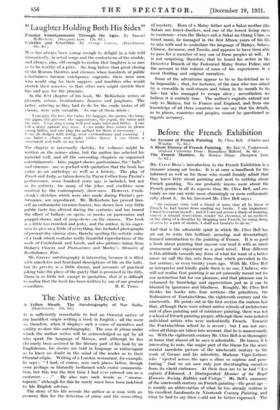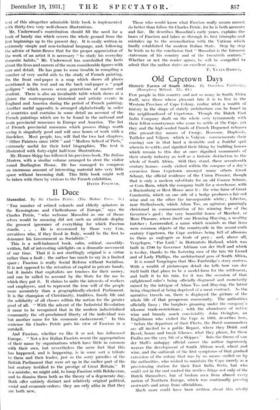Before the French Exhibition
A Short History of French Painting. By Eric G. Underwood.
7s. 6d.)
Mn. CLIVE BELL'S introduction to the French Exhibition is a treasure among art books. It is at once a handbook for the informed as well as for those who would frankly admit that they knew little about painting and next to nothing about French painting. No one probably knows more about the French genius in all its aspects than Mr. Clive Bell, and cer- tainly no one can write more charmingly or more enthusiasti- cally about it. In his foreword Mr. Clive Bell says : "An eminent critic told a friend of mine that all he knew of French he had learnt from reading my books. I am impenitent. I want to express myself ; and if I can put across a shade of meaning, convey a mental reservation, render the elevation of an eyebrow or the shrug of a shoulder by dropping into French, by using slang, or even by a pair of dashes, I shall not hesitate to do so."
And that is the admirable spirit in which Mr. Clive Bell has set out to write this brilliant, amusing, and devastatingly learned introduction to the painting of France. It is so good a book about painting that anyone can read it with as much amusement and enjoyment as a good novel. How different is this attitude towards any form of what for want of a better name we call the fine arts from that which prevailed in the last century, or even twenty years ago. With Mr. Clive Bell as interpreter and kindly guide there is no one, I believe, who will not realize that painting is an art primarily meant not for our instruction but for our pleasure, and that pleasure can be enhanced by knowledge and appreciation just as it can be blunted by ignorance and blindness. Roughly, Mr. Clive Bell divides his books into four sections—the primitives, the Italianizers of Fontainebleau, the eighteenth century and the nineteenth. He points out in the first section the curious fact that, although there were robust native schools of architecture and of glass painting and of miniature painting, there was not a school of French painting proper, although there were isolated individual artists who were undoubtedly French. Towards the Fontainebleau school he is severe ; but I am not sure, when all things are taken into account, that he isunnecessarily so. With the eighteenth century Mr. Clive Bell is so thoroughly at home that almost all he says is admirable. He traces, it is interesting to note, the major part of the blame for the senti- mental anecdotic picture of the nineteenth century to the work of Greuze and his inheritrix, Madame Vigee-Lebrun, who "ejected across the ages a slime so copious and pene-
trating" that we are now only just disentangling ourselves from its viscid embraces. At their door are to be laid "Les enfants d'Edouard, A Distinguished Member of the Royal Humane Society, Bubbles and Vertige." Mr. Bell's summary of the nineteenth century on French painting—the great age— is Mainly an abbreviation of what he has already written in his excellent Landmarks in Nineteenth Century Painting, and what he had to say then cauld not be better expressed. The
text of this altogether admirable little book is implemented with thirty-two very well-chosen illustrations.
Mr. Underwood's contribution should fill the need for a book of handy size which covers the whole ground from the first beginnings up to the present day. It is easily written in extremely simple and non-technical language, and, following the advice of Saint-Beuve that for the proper appreciation of the work of an artist it is necessary "to study his everyday domestic habits," Mr. Underwood has marshalled the facts about the lives and careers of the more considerable figures with care and detail. He has gone to some trouble in compiling a number of very useful aids to the study of French painting. On the front end-paper is a map which shows all places mentioned in the text and on the back end-paper a "pupil pedigree" which covers seven generations of master and student. There is also an invaluable table which shows at a glance the contemporary historical and artistic events in England and America during the period of French painting. Another useful appendix is arranged alphabetically in order of countries and contains in some detail an account of the French paintings which are to be found in the national and main provincial museums in Europe and America. The list of French provincial museums which possess things worth seeing is singularly good and will save hours of work with a Baedeker. Most people, too, will find the two last chapters, "Other Painters since 1870" and "Modern School of Paris," extremely useful for their brief biographies. The text is illustrated with forty-eight half-tone illustrations.
Mr. Horace Shipp has followed his previous book, The Italian Masters, with a similar volume arranged to steer the visitor round Burlington House. He has managed to compress an enormous amount of interesting material into very little space without becoming dull. This little book might well be taken with them by visitors to the French exhibition.
DAVID FINCIIANt.



































 Previous page
Previous page